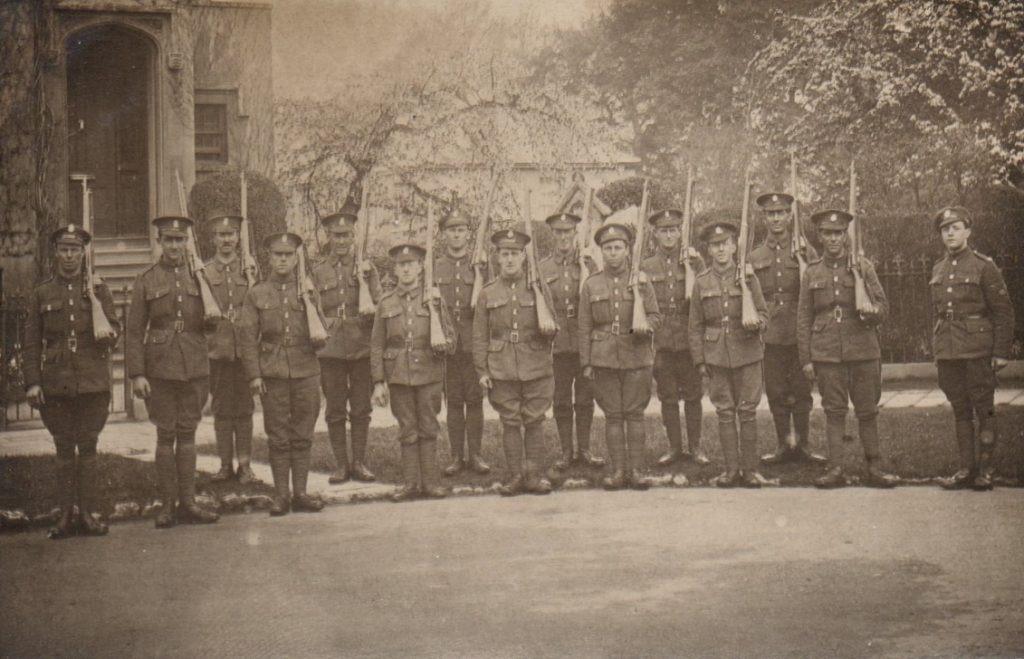THE COUNTY COBBLERS and THE BELGRAVIA WORKROOMS

No 8 Queen’s Parade, Cheltenham was home to the Gloucester County Association for Voluntary Organisations – a house lent by the Mayor William Nash Skillicorne and his sister Edith. One of the tasks carried out here was the cutting out and construction of slippers for men at rest stations and in military hospitals, under the chief cutter, the Revd. Cuthbert W. Birley, and run by Mrs Ernest Rogers. The voluntary workers – men and women – called themselves The County Cobblers. They paid for the material for the slippers themselves and at the start of the war were making 136 pairs of slippers a week!
 “There was an old woman who lived in a shoe
“There was an old woman who lived in a shoe
With the sewing of slippers she has much to do
So kindly please help her all people who can
To make the soft slippers for some wounded man”
This poem (found in an autograph book kept by Mabel Owen) is by a soldier in Naunton Park Hospital, Cheltenham. He obviously appreciated the slippers, which were probably a pair of those made at 8 Queen’s Parade.
The volunteer evening workers at the Belgravia Workrooms made items including slippers for soldiers from 14 North Street. These ladies worked during the daytime in the shops and offices. This national organisation‘s Cheltenham branch had been started in July 1916 by Miss Alice Crawley, a singing teacher at the Cheltenham Ladies’ College, with the help of Cheltenham Chamber of Commerce and the Traders’ Association. Within eleven weeks of opening they had 300 volunteers
By May 1918, there were now 80 workers, many working from home, and production in the first four months of 1918 had increased to 3,800 pairs of slippers. So popular had the slippers become that the Red Cross used the Revd. Birley’s patterns for working parties to make slippers throughout the country. It is known that the slippers from Cheltenham were sent not only to local hospitals (see picture below) but to hospitals as far apart as France and Salonika.
Having outgrown their premises at Queen’s Parade, the County Cobblers’ workrooms moved to “Edginswell” a ten-bedroomed house in Bayshill Road, next door to Curtis’s Private Hotel. From here they appealed for materials to make the slippers – cuttings from linings, old hunting coats and riding habits, faded felt surrounds and cork lino.
“Edginswell” also became the home of the Surgical Requisites Association Orthopaedic branch of the Queen Mary’s Needlework Guild for Plastic Work. The organisation made special surgical splints and boots for wounded soldiers in the Cheltenham VAD hospitals.
MABEL OWEN AND HER AUTOGRAPH BOOKS
Miss Mabel Owen of 1, Wellington Square, Cheltenham kept two small autograph books. On the inside page she wrote “For injured soldiers only”. The autographs are mainly witty poems, as was the fashion at the time. Mabel had written against some of the entries the name of the Cheltenham hospital where the soldier had been a patient.
It seems likely that she met these soldiers at one of the Soldiers’ Welcome clubs that catered for both billeted and injured soldiers throughout the town during the war. One of the Soldiers’ Welcomes was in The Rotunda.
The autograph books and photo below were kindly lent by Ian Brown.
A group of soldiers in Wellington Square, Cheltenham. On the back are the words: “No. 2 Section X 819 Company, Wellington Square 11th May 1917. Given by Pte Robinson.”
Cheltenham’s VAD (Voluntary Aid Detachment) Hospitals
During the First World War, Cheltenham had eight VAD hospitals run by the Red Cross. One of the hospitals – St John on Gloucester Road (see below) – was set up by the St John Ambulance Brigade and run by the Red Cross. St. John and Naunton Park Hospitals were located in schools.

The uniform that injured soldiers wore in hospitals can be seen in the postcard (see top of page) which injured soldiers would have sent to their families. The same picture was printed on many postcards with the name of the town changed according to where the hospital was located nationally.
Article by Neela Mann
Leave a Reply